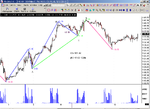Clylbw - what Socrates said is very sage - and makes perfect sense, that is exactly how big operators work. Not JUST on price btw - it is also a very common practice in trading options, when e.g. volatility skew explodes and big long put operators "cool down" the volatility on the downside - u get this period of both "healthy" volume and open interest on listed option with the volatility on that range of strikes sort of stuck - not going anywhere. Think abt it - it is all human nature games (with LOADS of ducats at stake) - btw this is why in all honesty I am so fascinated with the dark side - which bases trading decisions not on some mechanical indicator (no pun intended 🙂 ) but rather on realisation of what wud the crowd ruled by greed and fear do under circumstances.
let me think out loud here 🙂 and explore why particular price-volume patterns work so well in relation to UNDERSTANDING what they mean in terms of sussing what the crowd is doing. PLS NOTE - I will be very simplistic here - U ALWAYS HAVE TO VIEW THESE PATTERNS IN CONTEXT!!!! as stand-alones they may be VERY deceiving. Let us c - I will explore the bullish case:
a) Up maribozu on miniscule volume
b) Up maribozu on heavy volume
c) Doji on miniscule volume - or as in your Part 2 - steady but not too quick rise on little volume
d) Doji on high volume.
Let us think carefully - what do those mean?
a) price moves miles without any "resistance". What is it? NO ASKS IN THE BOOK LOG! Cavalry full gallop without a sign of the enemy! 🙂 It is NOT the most common pattern - e.g. it happened in the first minutes of the fall of 1929, when ppl were happy if they cud cancel their bids before they got hit. It is most likely the consequence of some major news or something of that sort. Yes, usually it is the beginning of some major move, but beware, it can be a trap - there can be heavily fortified "trenches" 20 miles further along the cavalry's advance 🙂
b) unlike previous "unhealthy" bull move this is most likely a "healthy" bull move - loads of bulls, strong resistance by bears, but bulls outnumber the bears and take the upper hand in heavy fighting (Battle of Kursk if I may be excused for repeating the analogy 🙂 ). HOWEVER CONTEXT IS KEY and I'll show why next.
d) (I am skipping c) for the time being). Heavy fight with price going nowhere. What does that mean? Obviously heavy buying meets heavy selling but what does THAT mean? 2 things - either as in your Part 1 the bulls r "colling down" the market after a big move OR bulls closing their longs and a potential reversal. NOW THINK ABOUT THIS: a maribozu up on heavy volume in a given 2 min interval followed by a maribozu down on a heavy volume over the next 2 minutes = a doji on a heavy volume on a 4 minutes interval!!!!!!! IS IT CLEAR NOW HOW THE CONTEXT IS KEY?
c) most probably your part 2 mate with the volume being the 2nd violin (consequential volume).
fascinating isnt' it? 🙂 For me personally loads more informative than finding out what the formula for calculating MACD(5,35,10) is 🙂



